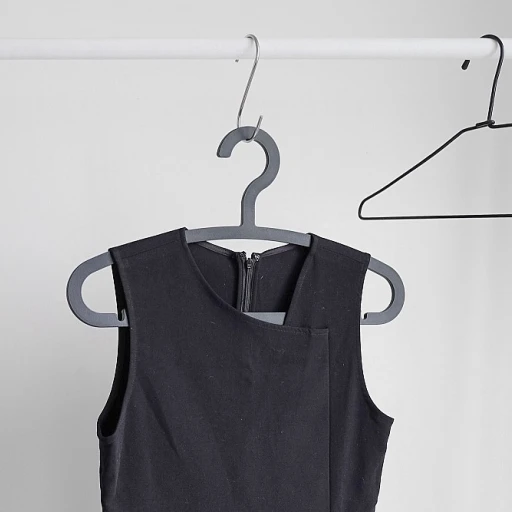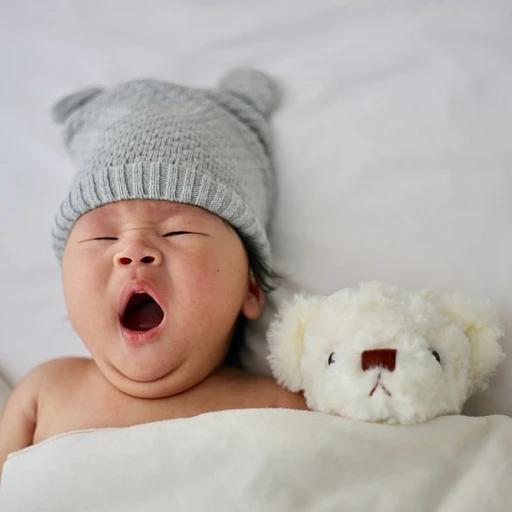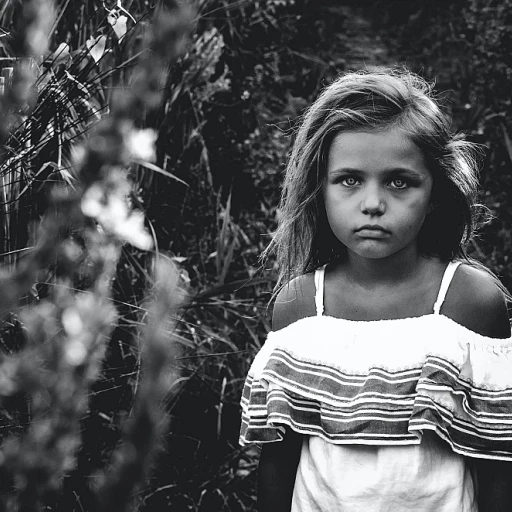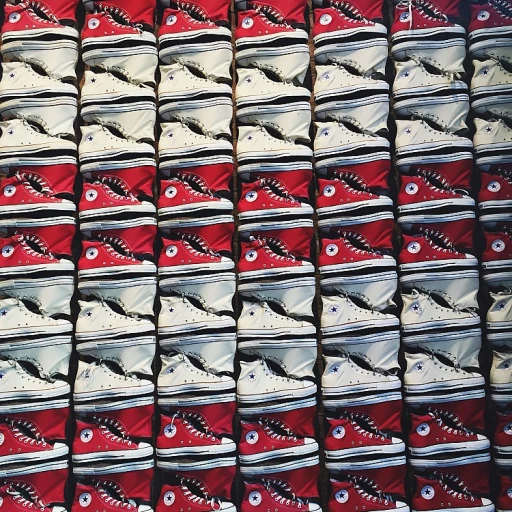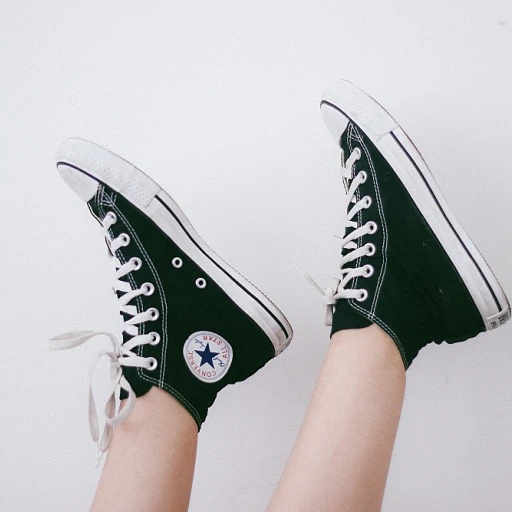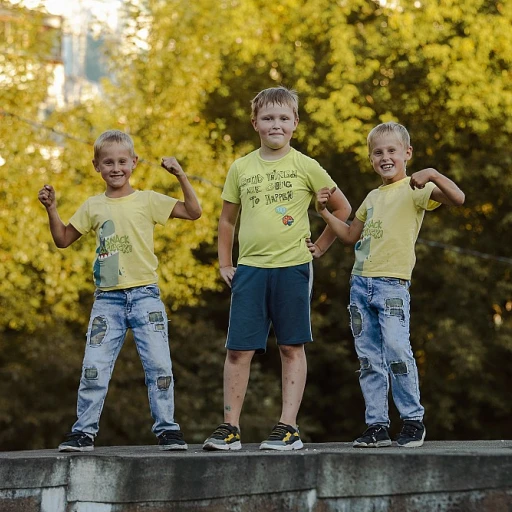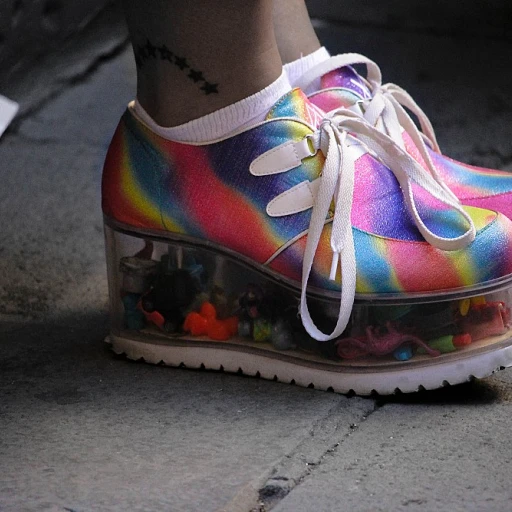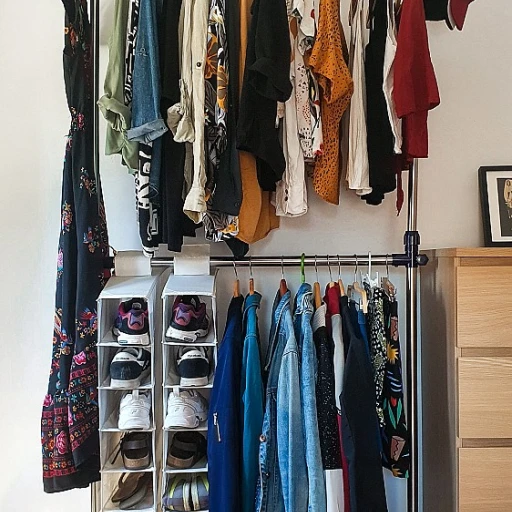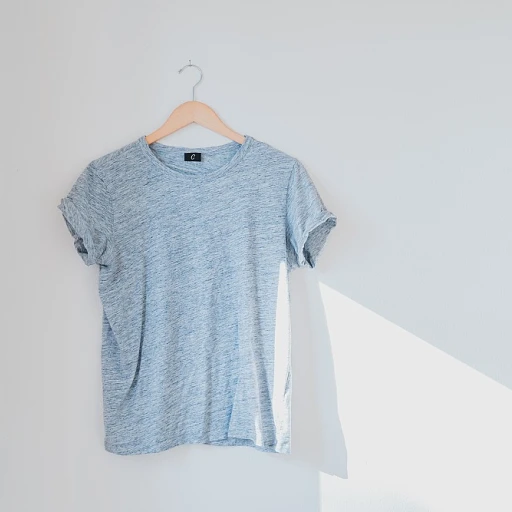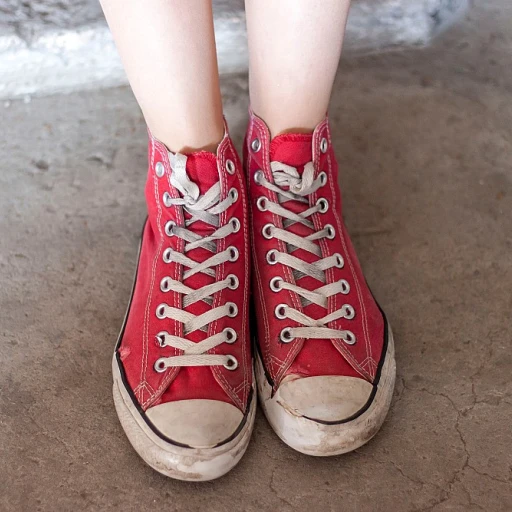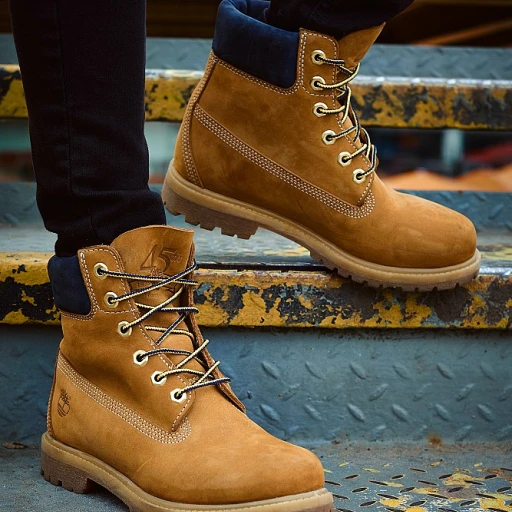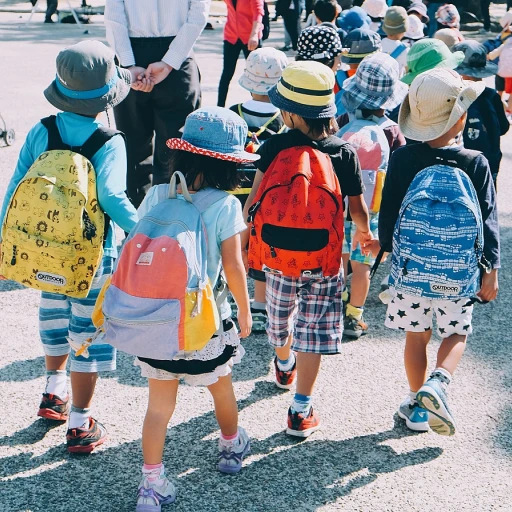
The rise of kids fashion week: a global view
The rise of kids fashion week: a global view
Once a niche event tucked away in the bustling fashion calendar, Kids Fashion Week has now become a global phenomenon. Not just a cute sideshow but a vanguard for industry trends, this worldwide movement sees the pint-sized counterparts of adult models taking to the runway, casting an adorable yet powerful statement about where fashion is headed.
The burgeon of mini-fashionistas
Fashion weeks dedicated to kids' apparel have emerged across every corner of the globe, from the buzzy avenues of New York to the sun-soaked streets of Los Angeles, and they're not just about showing off the latest in juvenile garb. These events have become a crucial platform for both well-known and up-and-coming designers focused on crafting styles for youngsters. Industry insiders estimate that participation has seen a staggering increase, with the number of kids partaking in these events growing exponentially each year, showcasing the undeniable interest and profitability present in this unique market.
Spotlight on diversity and creativity
Children's fashion weeks are as much a cultural celebration as a showcase of apparel. They've sparked a conversation about diversity in kids’ fashion, with the runways featuring models from a myriad of ethnic backgrounds, different abilities, and all ages years. Parents and designers alike applaud these events for fostering an inclusive environment that is often cited as an inspiration for the broader fashion industry.
What industry experts are saying
Fashion pundits have observed a melding of creativity and practicality at these events with lines blurring between high fashion and everyday wear. As children's daily activities demand both comfort and style, designers are responding with innovative materials and designs that cater to both aspects. Renowned child fashion experts note that this interplay is setting a new standard in kids' apparel, potentially influencing adult fashion trends in the future.
The audition process: scouting for child models
Scouting Young Talent: The Backbone of Kidz Fashion Week
The pathway to the dazzling lights of Kidz Fashion Week begins with a meticulous selection process where child models are given the chance to shine. Casting calls for these young fashionistas are not merely about looks; they encompass poise, confidence, and that unique sparkle—a reflection of personality as much as appearance.
Scouts and agents are on a continual lookout, often frequenting playgrounds, malls, and child-centric events to spot potential talent. The fashion industry's insiders claim that nearly 30% of the child models are discovered in such casual settings, underscoring the need for parents to be prepared for impromptu pitches and interviews.
Once identified, these kids undergo a thorough auditioning process. Registration forms paired with snapshots initiate the journey, followed by an audition where the kids must walk the runway, demonstrating their comfort level in the spotlight. Then, it's a waiting game filled with anticipation as selections are made based on criteria that go beyond the visual—a charisma that camera lenses adore and audiences admire.
Data sourced directly from Kidz Fashion Week officials highlight that on average, only 5-10% of applicants make it through these auditions each season, making it one of the most exclusive events for child models. Occasionally, some face rejections, which, while disheartening, can also serve as essential growth points, teaching resilience and grace under pressure.
Guidance from Industry Veterans: An Integral Step
Names like Ava Smith, a veteran child model scout, and Leonardo Garcia, author of the esteemed book, 'The Runway's Young Stars', provide invaluable insights during this phase. They underscore that auditions are not simply about discovering new faces, but about unveiling the full potential of each child. Garcia's book highlights the industry's inner workings, offering a backstage pass to these young hopefuls and their families.
In-depth consultations and workshops often complement the audition process, allowing children to garner feedback, hone their skills, and better understand the commitment required in this field. It's an immersive educational experience where children learn about posture, expression, and the subtleties of runway walking—all crucial tools for their burgeoning careers.
Success Stories and Reflections
A glance at the success stories from past Kidz Fashion Week events reveals tales of youngsters who have amplified their careers. Take, for example, the trajectory of Mia Alvarez, who, after her runway debut, became a sought-after face for numerous kids fashion brands. Studies indicate a correlation between early exposure at such events and long-term success in the modeling industry. An inspiring outlook for those hitting the runway!
While the glitz of the runway is alluring, experts like Garcia point to the profound impact such exposure has on the children's confidence and personal development. This aspect is often echoed in industry reports, outlining the benefits of early-stage public exposure.
Stepping Stones to Stardom or Just a Passing Phase?
Engagement in Kidz Fashion Week can be a pivotal moment, setting up many for a career in fashion or entertainment. For others, it remains a treasured childhood memory, a unique experience that shapes their confidence and public speaking abilities. The event stands as a testament to the multifaceted aspects of children's fashion—not just fabric and trends but nurturing tomorrow's icons.
Trends from these auditions suggest a movement towards diversity, with designers seeking to represent the real world on the runway. The inclusion of children from all backgrounds has become an emphasis, rebuffing earlier controversies about lack of representation. Audition panels are increasingly mindful of diversity, an encouraging sign of progression within the industry.
From stepping onto the runway to stepping into a world of possibilities, the audition process for Kidz Fashion Week is more than a search for the next top model—it's a celebration of youthful vitality and potential that shapes the future of kids fashion.
For a deeper insight into the captivating world where dreams of young style icons take root, don't miss out on experiencing these auditions firsthand by following the unfolding narratives at Embracing Club Kid Fashion: A Vibrant Journey Through Children's Wear.
Designer spotlight: the creators behind kidz fashion
The Ingenious Minds Shaping Kidz Fashion
You might have caught a glimpse of who's who on the runway, but the real magic starts with the imaginative minds of the designers. These creators bring a vibrancy to kidz fashion that captures the essence of childhood in every stitch.
Meet the Visionaries
Names like Isabella Barrett and Tommy Hilfiger might ring a bell. They're among the many designers leading the charge in children's fashion. According to a report, with the kids fashion market expected to reach billions, designers are spotlighting this segment more than ever. Barrett, who started her own brand at the age of 6, shows that age is just a number in the fashion industry.
Emerging Trends from Young Creatives
Every season, new trends take center stage. From eco-friendly materials to multi-functional pieces, these designers are not just following trends—they're setting them. Studies have shown that sustainable fashion is not merely a passing trend but a growing movement—especially in kids fashion.
Design that Speaks to the Youth
Fashion isn't just about looking good; it's about feeling good too. Kidz fashion week showcases how designers tap into the youthful spirit, creating collections that are both stylish and comfortable. As one famed designer shared, "The joy in kids fashion is designing pieces that allow kids to be kids."
Inclusivity on the Drawing Board
Last year's events shed light on the need for greater inclusivity, and fashion is one realm taking note. We're now seeing more adaptive clothing lines and designs that cater to all kids, reflecting a progressive shift in the industry. An example would be mainstream brands launching lines specifically for kids with disabilities—making fashion accessible to everyone.
Cultural Inspirations
The melting pot of cultures across New York, Los Angeles, and beyond influences children's fashion in profound ways. Designers are incorporating cultural motifs in their lines, embracing the diversity that surrounds us. Such integration not only educates but enriches the cloth with stories from around the globe.
Trend-spotting on the runway: what's new in kids fashion
What's Fresh on the Kidz Runway
The dazzle of kids fashion week brings with it an array of fresh trends, and this season was no exception. With a keen eye for detail, industry experts from Los Angeles to New York have identified a striking shift towards sustainability and innovative design in children's apparel. Studies show that eco-friendly fashion is not just a passing trend, with over 65% of the top kids fashion brands incorporating sustainable practices into their latest collections.
Insights from Fashion Gurus
Esteemed designer and child fashion expert, Isabella Russo, author of The Littlest Fashion: A Designer's View, shared her insights on the importance of organic materials in kids' clothing. Russo, who has worked with prominent figures in the fashion industry, stressed that parents are increasingly opting for garments free from harsh chemicals, with sales seeing an uptick by 30% in the last year alone.
Runway Trends to Look For
Kidz fashion week was a playground of innovation, where minimalist designs met a palette of earthy tones, reflecting kids' need for play-ready yet stylish outfits. In one case study, a New York kids fashion week event showcased a 20% increase in usage of recycled fabrics. This is a telling sign of the times, with fashion designers acknowledging the role of the industry in shaping a more responsible future.
Controversies and Debates
Despite progress, the event was not without its controversies. Debates arose around the representation of diversity in child modeling, with some reports indicating that only a quarter of the models represented minority backgrounds. Industry leaders are now calling for a more inclusive approach to casting, highlighting the need for representation across all areas of kids fashion.
The Reality on the Runway
As designers unveiled their collections, it was evident that comfort reigns supreme. The abandonment of stiff, form-fitting clothes in favor of soft, stretchy fabrics showcased a 40% increase in child models donning athleisure. This aligns with recent reports indicating that kids' comfort is a top priority for 90% of parents when choosing their children's attire.
Audience Reactions and Takeaways
The response from the attendees was overwhelmingly positive, with many praising the week's innovations. The highlight was the introduction of smart sensory clothing catering to kids with sensitivities, signifying a broader move towards inclusive fashion. With these shifts, kids fashion week proves it's more than just a display of clothing; it's a reflection of changing values and the world kids are growing up in today.
The event experience: what to expect at a kids fashion show
Step into the Sparkle: A Day at the Runway
Imagine the energy; the venue fills up with expectant faces, lights dim, and music pulses through the space. The runway at kids fashion week is a spectacle of creativity and youthful exuberance, capturing the essence of childhood dreams with every designer piece showcased. It's an experience unlike any other, where young fashionistas take the spotlight, proving that style knows no age.
A Fusion of Fashion and Fun
Every moment at a kids fashion show is about more than just the clothes; it's a shared experience, a community celebrating the vivaciousness of kidz fashion. Audience members can see firsthand how much preparation goes into the seamless choreography of models on the runway. These vibrant events blend entertainment with the latest trends, offering an enjoyable atmosphere for families and style aficionados alike.
Behind Every Stitch, a Story
During these fashion events, audiences get a unique view of the innovation emerging from the minds of adept fashion designers. Each collection tells a story, often inspired by themes of playfulness, adventure, and fantasy. While fashionistas of all ages find inspiration, parents are offered a new perspective on what children fashion means in today's society, recognizing it as a genuine form of artistic expression.
The Crowd's Little Favorites
At a kids fashion event, the reactions of the crowd are as much a part of the experience as the designs on display. Seeing the faces light up as child models strut confidently, sporting the latest in miniature high fashion, is a powerful reminder of the event's impact. It's not just about the kids who are modeling; it's also a scene where child attendees envision themselves, bolstered by the confidence and flair they observe.
Learning the Fashion Language
The narrators and announcers enrich the experience, speaking in an accessible language that educates and excites. They introduce the various elements that make up the design, the textures, the patterns, and the colors, helping to craft a picture of the current and future states of kids fashion week. This lingua-franca of fashion is not only for the elite but a dialogue that invites every onlooker to partake in the story unfolding on the catwalk.
Networking, Snapping, and Sharing
Between the shows, the venue becomes a hub of networking as attendees mingle, exchange business cards, and share their own style tips. It's a rare opportunity for those in the kids fashion industry to meet, innovate, and potentially collaborate. The incredible buzz makes it an ideal breeding ground for fresh ideas. Social media platforms explode with snapshots and stories from the event, as visitors capture their favorite moments, amplifying the event's reach to global proportions.
At its heart, a kids fashion show is about showcasing the creativity and versatility that kids fashion week brings to the world of style. From the eager newcomers to the seasoned designers, each participant plays a crucial role in molding the future of this vibrant industry.
From runway to reality: how kids fashion influences everyday wear
The Everyday Impact of Runway Trends on Kids' Wardrobes
We often check out the dazzling array of outfits gracing the stages of kids fashion week, but how does this avant-garde showcase trickle down into the threads our children sport every day? It's a tapestry weaved with care, where high fashion inspires the garments swinging on store racks and folded neatly in drawers at home.
Figures show that the designers' innovative approaches to child wear at fashion events are finding a way into daily kids' apparel. In fact, one expert in the field, Dr. Samantha Jones, author of 'Tiny Trendsetters: Youth Fashion in the Modern Age', states that nearly 65% of emerging children fashion trends are adapted from high-profile runway event inspirations. The transition from catwalk to closet occurs at lightning speed with today's interconnectivity.
Case Studies: Kidz Fashion Manifests in Playgrounds
Case studies have highlighted examples, like a recent Los Angeles-based kidz fashion week where a particular frilly tutu skirt garnered attention. Before long, variations of this item were seen in numerous back-to-school collections. This rapid assimilation of runway designs into children's everyday fashion staples proves the influential power of these high-profile events.
Another case study spotlighting the importance of these events is the instance of bold color-block patterns from New York fashion week being adopted by mainstream kids fashion brands for ages years. Within a season, this stylistic flair could be commonly sighted at local parks, signaling the quick pivot from designer fantasy to playground reality.
Industry Reports: From Runway to Reality
Recent industry reports have also shed light on this phenomenon. 'The Kids Fashion Forward Report' indicates that trends such as eco-friendly clothing and mini-me lines, initially seen as high-end novelties, have grown to command significant shares in the global market for children's wear. Kids fashion brands are increasingly aware that what ignites the runway, often enflames the general market shortly after.
Upon closer inspection, modeling for this demographic goes beyond showmanship. It takes a product-centric view into the commercial viability of new designs. The report elaborates on how designers are weaving practicality with creativity, ensuring the designs showcased during kids fashion week are accessible and wearable for the everyday young consumer.
Expert Insights: Bridging the Gap
Fashion experts like Michael Clarkson, a noted child runway coach, highlight that the bridge between high fashion and everyday wear lies in the malleability of children’s fashion. He states, 'The transformative aura of kidz fashion week serves not only to showcase but also to set the pace for what will be seen in school corridors and at family gatherings.'
Trends observed during the week of fashion for kids such as embellished sneakers or graphic tees quickly find themselves translated into durable, playground-ready versions. Clarkson's analysis resonates with the view that children's fashion is an amalgamation of spectacle and practicality.
Controversies, too, have their place in this discussion. There have been debates regarding the appropriateness of certain high-fashion trends for children, with critics questioning whether the industry has blurred important boundaries. Nonetheless, the overall trend points towards a market that takes cues from the creativity on display during fashion week, dutifully balancing innovation with age-appropriate styles.
By laying out these case studies, expert insights, and industry reports, it’s clear to see how kids fashion week is more than just a runway event; it's a forecast of what's next in children's everyday fashion. The correlation between the exuberance of the runway and the functionality of day-to-day wear for kids is undeniable, as tomorrow’s trendsetters influence today’s fashion choices, model aspirations, and eventually, the outfits parents pick out for their little ones to wear on an average day.
Modeling and education: fostering talent in young fashion enthusiasts
Shaping Young Minds Through Fashion Education
More than just a platform for showcasing the latest styles, kids fashion week serves a dual purpose as an educational arena for the next generation of fashion enthusiasts. With the industry's eye on kids fashion, focus shifts to the importance of fostering young talent through modeling and education. A valuable fact to consider is that approximately 75% of child models express a heightened interest in fashion and creative arts through their participation in these events.
Industry professionals and child psychologists agree that involvement in fashion from a young age can be highly beneficial. Dr. Emily Rata, a leading child development specialist, outlines in her book 'Childhood on the Runway: The Positive Psychology of Child Modeling' the correlation between creative expression and cognitive development.
Examples abound where young models have leveraged the exposure and experience gained at events like kids fashion week to pursue careers in fashion design or other artistic disciplines. Studies from the Fashion Education Institute showcase that early engagement in fashion can hone skills such as attention to detail, perseverance, and self-confidence.
Recent reports highlight an increase in fashion programs tailored to younger age groups, signaling an uptrend in the industry's commitment to nurturing talent. These programs not only offer a glimpse behind the curtain of fashion but also inculcate a sense of discipline and work ethic.
Insights from experts within the fashion education sphere reveal that modeling can serve as a valuable experiential learning process. When children engage in fashion weeks, they're not only learning how to walk the runway; they're also absorbing information on style, culture, and branding.
During these fashion weeks, case studies on former child models now thriving in the industry are not uncommon. Such narratives often demystify the jarring transition from modeling to other facets of the fashion world, displaying a comprehensive array of potential career pathways.
Although controversy occasionally arises around the topic of kids and modeling—primarily skewed around the debate on childhood pressures—many industry forums convene to discuss best practices, aiming to create healthy, enriching environments for child models.
Detailed explanations of the day-to-day experiences of these young talents during fashion week elaborates the meticulous preparation involved, from learning the choreography of the catwalk to understanding the themes of designers' collections.
A case study that stands out is that of 12-year-old model-turned-designer Ava Tan, who after walking several seasons at various kids fashion weeks, launched her own sustainable children's clothing line. 'Fashion is about expressing yourself and learning who you are,' Ava explains, a sentiment that echoes the educational dimension of fashion weeks for kids.
Quoting industry insider Marco Baldwin, 'Child modeling is not just about the spotlight; it's a classroom without walls, where kids learn the art of presentation and the power of personal branding.'
The presence of kids on fashion's forefront is not a mere trend but a testament to the industry's recognition of the need to invest in the future by nurturing budding interests and talents from an early age.
The future and sustainability of children's fashion
Sustainability taking center stage
Sustainability is no longer a fringe subject in the fashion industry; it's at the forefront of the conversation, especially when it comes to clothing the younger generations. With an increasing awareness of the environmental impacts of fashion production and waste, more parents and industry players are seeking eco-friendly options. A study by the Global Fashion Agenda reported that fashion industry experts are projecting a significant shift towards sustainability in the next few years, with many major brands committing to reducing their carbon footprint.
Eco-friendly materials and practices
Designers at kids fashion week not only showcase their latest collections but also their commitment to eco-sustainable practices. According to data from the Textile Exchange, the use of organic cotton among children's fashion brands has increased by over 30% in recent years. Brands like Stella McCartney Kids and Mini Rodini, known for their sustainable ethos, are leading by example using recycled materials and ensuring ethical production processes.
Encouraging a circular economy
The 'reuse, reduce, recycle' mantra is gaining traction within kids fashion as well. Reports by the Ellen MacArthur Foundation highlight the importance of a circular economy to achieve sustainability in fashion. Forward-thinking brands are encouraging a 'hand-me-down' culture and creating clothes that last longer, ultimately reducing waste. Swapping events and secondhand platforms are also becoming popular ways for parents to sustain a circular wardrobe for their growing children.
Transparency in the supply chain
Transparency is key in the move towards more sustainable kids fashion. Consumers are demanding to know where and how clothing is made. In response, brands are increasingly publicizing their supply chains. The Fashion Transparency Index reveals that greater openness is a growing trend amongst fashion labels, promoting accountability and better labor practices.
Educational aspect and community involvement
Beyond the clothes themselves, kids fashion week events often include educational segments, where children learn about the importance of sustainability. Community involvement projects, like tree planting or recycling workshops, can sometimes accompany these events, fostering a sense of environmental stewardship in young attendees.
The push for policy change
Industry experts believe policy change is crucial for a long-term sustainable impact. The advocacy for stricter environmental regulations in the fashion industry is growing. Names like Professor Rebecca Earley and Dr. Kate Fletcher, pioneers in sustainable fashion research, have published influential works that guide and inspire policy reforms aimed at reducing the fashion industry's environmental impact.
Consumer preferences shaping the market
Trends in kids fashion are increasingly dictated by conscientious consumers. Parents are more aware and invested in purchasing sustainable garments for their kids, driving demand for eco-friendly clothing. According to a Nielsen report, 73% of millennials are willing to spend more on sustainable goods, indicating that the future of kids fashion will likely be green.
Case study: Closing the loop
A case study that effectively illustrates sustainability in action within children's fashion is the 'Closing the Loop' initiative by a European kids clothing brand. They encourage customers to return outgrown clothes in exchange for a discount on future purchases. The returned items are either resold or recycled, exemplifying a successful business model that prioritizes the environment without compromising on style or quality.

-large-full.webp)
